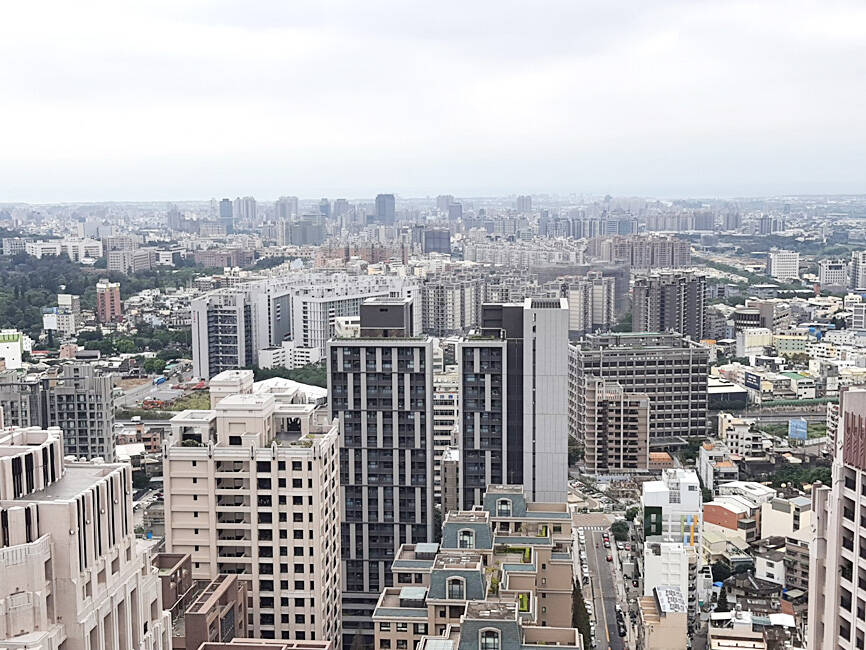New apartments in Taiwan’s major cities are getting smaller, while old apartments are increasingly occupied by older people, many of whom live alone, government data showed.
The phenomenon has to do with sharpening unaffordable property prices and an aging population, property brokers said.
Apartments with one bedroom that are two years old or older have gained a noticeable presence in the nation’s six special municipalities as well as Hsinchu county and city in the past five years, Evertrust Rehouse Co (永慶房產集團) found, citing data from the government’s real-price transaction platform.

Photo: Hung Mei-hsiu, Taipei Times
In Taipei, apartments with one bedroom accounted for 19 percent of deals last year, an increase of 19 percentage points from 2019, Evertrust deputy research head Chen Chin-ping (陳金萍) said.
At the same time, apartments with two, three and four bedrooms or more shed 1.1 percentage points to 9 percentage points, Chen said.
The bigger the apartment, the higher the value, making them less likely to change hands, she said.
Likewise, apartments with one bedroom last year made up 10.9 percent of transactions in New Taipei City and underpinned 14.2 percent of deals in Taichung, representing advances of 7.7 percentage points and 10.8 percentage points respectively from five years earlier, Everturst said.
The trend was also seen in Taoyuan, Tainan and Kaohsiung, as well as Hsinchu county and city, although at a less conspicuous pace, it said.
Apartments with one bedroom contributed 8.4 percent of deals in Taoyuan, 8.8 percent in Hsinchu county and city, 9.6 percent in Tainan and 6.7 percent in Kaohsiung, it said, adding that the figures suggested gains of 3.5 to 8.1 percentage points.
Although apartments with two and three bedrooms remain the mainstream, a growing number of buyers, especially young people, have settled for less space so as to become homeowners, Evertrust said.
People in Tainan and Kaohsiung still favor apartments with three or four bedrooms given that they constituted 40 percent of deals, Chen said.
However, the preference could lose momentum if prices continue to soar and become untenable, she said.
Price increases have been less drastic in Taipei and New Taipei City in the past five years compared with elsewhere in Taiwan, but an already high base makes them beyond reach, Chen said.
Meanwhile, the number of old houses occupied by older people climbed to a record high of 690,500 in the third quarter of 2022, 75.42 percent of which had lone occupiers, raising safety concerns and the urgency of urban renewal projects, the Ministry of the Interior said.
The average age of residential property in Taiwan is 33 years, while the figure is 37.75 years in Taipei, the ministry said.
More old apartments would have lone occupants in light of a rapidly aging society and a low birthrate, it said.
The National Development Council has estimated that Taiwan would become a super-aged society next year when more than 20 percent of the population is aged 65 or older.

Taiwan will prioritize the development of silicon photonics by taking advantage of its strength in the semiconductor industry to build another shield to protect the local economy, National Development Council (NDC) Minister Paul Liu (劉鏡清) said yesterday. Speaking at a meeting of the legislature’s Economics Committee, Liu said Taiwan already has the artificial intelligence (AI) industry as a shield, after the semiconductor industry, to safeguard the country, and is looking at new unique fields to build more economic shields. While Taiwan will further strengthen its existing shields, over the longer term, the country is determined to focus on such potential segments as

UNCERTAINTY: Innolux activated a stringent supply chain management mechanism, as it did during the COVID-19 pandemic, to ensure optimal inventory levels for customers Flat-panel display makers AUO Corp (友達) and Innolux Corp (群創) yesterday said that about 12 to 20 percent of their display business is at risk of potential US tariffs and that they would relocate production or shipment destinations to mitigate the levies’ effects. US tariffs would have a direct impact of US$200 million on AUO’s revenue, company chairman Paul Peng (彭雙浪) told reporters on the sidelines of the Touch Taiwan trade show in Taipei yesterday. That would make up about 12 percent of the company’s overall revenue. To cope with the tariff uncertainty, AUO plans to allocate its production to manufacturing facilities in

COLLABORATION: Given Taiwan’s key position in global supply chains, the US firm is discussing strategies with local partners and clients to deal with global uncertainties Advanced Micro Devices Inc (AMD) yesterday said it is meeting with local ecosystem partners, including Taiwan Semiconductor Manufacturing Co (TSMC, 台積電), to discuss strategies, including long-term manufacturing, to navigate uncertainties such as US tariffs, as Taiwan occupies an important position in global supply chains. AMD chief executive officer Lisa Su (蘇姿丰) told reporters that Taiwan is an important part of the chip designer’s ecosystem and she is discussing with partners and customers in Taiwan to forge strong collaborations on different areas during this critical period. AMD has just become the first artificial-intelligence (AI) server chip customer of TSMC to utilize its advanced

While China’s leaders use their economic and political might to fight US President Donald Trump’s trade war “to the end,” its army of social media soldiers are embarking on a more humorous campaign online. Trump’s tariff blitz has seen Washington and Beijing impose eye-watering duties on imports from the other, fanning a standoff between the economic superpowers that has sparked global recession fears and sent markets into a tailspin. Trump says his policy is a response to years of being “ripped off” by other countries and aims to bring manufacturing to the US, forcing companies to employ US workers. However, China’s online warriors